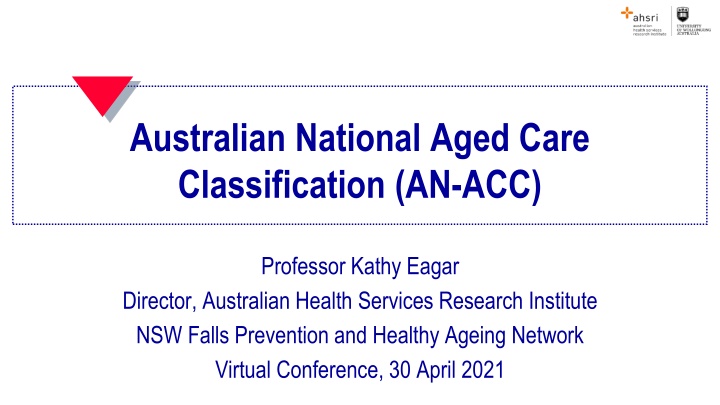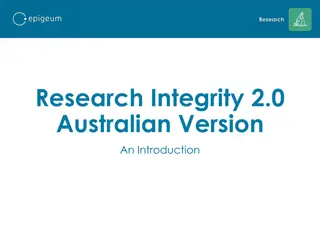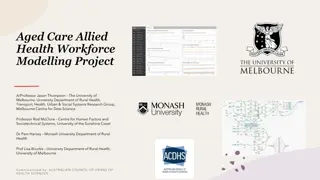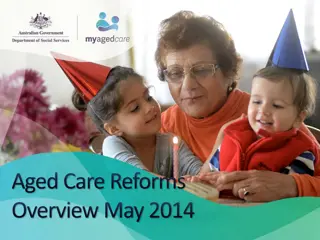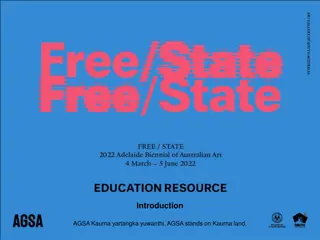Overview of Australian National Aged Care Classification
The Australian National Aged Care Classification (AN-ACC) aims to replace the current ACFI system due to inequitable outcomes and funding uncertainties. The new model emphasizes separate assessments for funding and care planning, with core elements focusing on resident needs and payment classes. With a focus on frailty profiles and funding adjustments for new residents, AN-ACC offers a more holistic approach to residential aged care.
Download Presentation

Please find below an Image/Link to download the presentation.
The content on the website is provided AS IS for your information and personal use only. It may not be sold, licensed, or shared on other websites without obtaining consent from the author.If you encounter any issues during the download, it is possible that the publisher has removed the file from their server.
You are allowed to download the files provided on this website for personal or commercial use, subject to the condition that they are used lawfully. All files are the property of their respective owners.
The content on the website is provided AS IS for your information and personal use only. It may not be sold, licensed, or shared on other websites without obtaining consent from the author.
E N D
Presentation Transcript
Australian National Aged Care Classification (AN-ACC) Professor Kathy Eagar Director, Australian Health Services Research Institute NSW Falls Prevention and Healthy Ageing Network Virtual Conference, 30 April 2021
Overview Profile of people living in residential aged care in 2021 Outline the new Australian National Aged Care Classification (AN-ACC) Designed to replace the current ACFI ACFI is no longer fit for purpose Inequitable outcomes (geographic and socioeconomic) Creates perverse incentives for income maximisation resulting in funding uncertainty
Profile and care needs of residents The important place to start
180,000 beds 240,000 residents pa 60,000 deaths, another 60,000 take their place 30,000 people over 95 years 4,300 aged 100-108 years 64% women
The Australian National Aged Care Classification (AN-ACC) and funding model Expect government to announce AN-ACC in the May 2021 budget
Six core elements (1) Separate assessment for funding from assessment for care planning Assessment for care planning to be undertaken by the residential aged care facility based on resident needs, strengths and preferences Assessment for funding purposes to be undertaken by external assessors capturing only the information necessary to assign a resident to a payment class
Six core elements (2) One-off Adjustment payment for each new resident recognising additional, but time-limited, resource requirements when someone initially enters residential care Base Care Tariff: covers the fixed daily costs of care that are shared equally by all residents (~50%) varies by location AN-ACC Care Payment: variable price per day for the costs of individualised care for each resident (~50%) based on each resident s AN-ACC class price per class is standardised across Australia
What drives care costs? Not medical diagnosis / diagnoses So Diagnosis Related Group concepts are not relevant Costs are driven by care burden from: Mobility, end of life needs, frailty, functional decline, cognition, behaviour and technical nursing needs These may be due to one or more diagnoses Including dementia, mental health disorders, physical health etc But the diagnosis per se is not a cost-driver
Capacity drives care needs and costs AN-ACC assessment captures resident capacity taking into account: Physical ability (including pain) Cognitive ability (including ability to communicate, sequence, socially interact, problem solve, memory) Mental health issues (including depression and anxiety) Behaviour (including cooperation, physical agitation, wandering, passive resistance, verbal aggression etc) It thus captures the functional consequences of health conditions (eg, dementia) rather than the condition itself
All residents Mobility Class 1 Admit for Palliative Care Independent mobility (15%) Assisted mobility (50%) Not mobile (35%) Low Lower function and lower pressure sore risk Class 11 Without CF Class 2 cognitive ability Class 8 Medium cognitive ability Higher cognitive ability Lower function and higher pressure sore risk Higher function Without CF Class 9 Without CF Class 6 Without CF Class 4 With CF Class 3 Without CF Class 12 With CF Class 10 With CF Class 7 With CF Class 5 With CF Class 13 AN-ACC V1 CF = Compounding Factors
Compounding factors in each branch
Each AN-ACC class Represents residents with similar needs for care hence an evidence-based predictor of inputs (staff time) Represents residents who cost about the same to care for each day hence an evidence-based unit of output (payment ) Represents residents whose clinical risks and outcomes are similar hence an evidence-based way of measuring outcomes by risk adjusting quality and safety indicators
Relative individual care time by class Class 1 Admit for Palliative Care All residents 100% Mobility (DEMMI) 195% Independent mobility Assisted mobility Not mobile Lower function and lower pressure sore risk Class 11 163% Low Without CF Class 2 37% Lower function and higher pressure sore risk Medium cognitive ability Higher cognitive ability cognitive ability Class 8 105% Higher function Without CF Class 9 106% Without CF Class 6 69% Without CF Class 12 159% Without CF Class 4 41% With CF Class 3 61% With CF Class 10 170% With CF Class 7 95% With CF Class 13 195% With CF Class 5 73%
Mortality rates by class 4-6 months after initial AN-ACC assessment
Base care tariff Base Care Tariff 1 2 3 4 5 6 All Facility description Indigenous, MMM=7 Indigenous, MMM=6 Non-indigenous, MMM=6-7, < 30 beds Non-indigenous, MMM=6-7, 30+ beds Specialised homeless All other RACFs RVU 463% 162% 187% 106% 179% 95% 100%
AN-ACC NWAU AN-ACC NWAU 1.00 0.19 0.31 0.21 0.37 0.35 0.49 0.54 0.54 0.87 0.83 0.81 1.00 5.28 AN-ACC class Resident description Class 1 Class 2 Class 3 Class 4 Class 5 Class 6 Class 7 Class 8 Class 9 Class 10 Class 11 Class 12 Class 13 Adjustment payment Admit for palliative care Independent without CF Independent with CF Assisted mobility, high cognition, without CF Assisted mobility, high cognition, with CF Assisted mobility, medium cognition, without CF Assisted mobility, medium cognition, with CF Assisted mobility, low cognition Not mobile, higher function, without CF Not mobile, higher function, with CF Not mobile, lower function, lower pressure sore risk Not mobile, lower function, higher pressure sore risk, without CF Not mobile, lower function, higher pressure sore risk, with CF
AN-ACC reassessment That the new AN-ACC funding model allow for reassessment based on significantly increased needs as indicated by: (1) a significant hospitalisation (2) a significant change in mobility and/or (3) a standard time period 12 months for Classes 2 to 8 (classes with lower mortality rates) and 6 months for Classes 9 to 12 (frailer and higher mortality rates) That there be no requirement for reassessment in the AN-ACC funding model.
Adjustment payment That the Commonwealth build strong accountability into the system to ensure that the adjustment payment be used for the intended purpose, not added to the bottom line and not contracted out to third party providers
Ongoing research and development That Government commit to an ongoing aged care research and development agenda that builds on the work of the RUCS and that includes assessment, classification, costing and outcome studies. That a study equivalent to RUCS be undertaken in the community aged care sector with a view to expanding AN- ACC so that it includes aged care delivered in all settings.
More information Final reports https://agedcare.health.gov.au/reform/resource-utilisation-and- classification-study OR https://ahsri.uow.edu.au/rucs/index.html Journal article https://www.mja.com.au/journal/2020/213/8/australian- national-aged-care-classification-acc-new-casemix- classification
